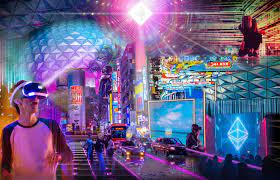Is metaverse a concept hype or the next technological windfall?
The metaverse will either become the next frontier of the Internet’s great potential, or it will become another overhyped phenomenon since the new Coca-Cola.

There is no doubt that the term metaverse, still loosely defined and difficult to categorise, is still in the hype cycle.
“The metaverse has the potential to generate up to $5 trillion in value by 2030, and because the metaverse is really too big for companies to ignore it,” McKinsey mentioned in its metaverse market report last month.
The US consultancy estimates that major corporations have invested more than US$120 billion in metaverse projects so far this year.
The influx of money and talent to build the metaverse could mean that this interconnected virtual world will realise its potential - after all, the metaverse is still in its infancy and no judgement can be drawn yet.
But critics say that slow user growth on some of the big platforms, ugly user interfaces and the influence of ‘tech geeks’ are throwing cold water on this promising new era of the internet.
And it all points to the same question: can the development cycle of the metaverse really outlast its hype cycle?
METAVERSE
What is the metaverse?
First, we need to understand the basics. A metaverse connects the real world with the virtual world, allowing us to work, learn, play and socialise in a more realistic and immersive environment than most of the web currently offers.
The metaverse is difficult to define strictly, as for some people, attending a Zoom meeting counts as an interaction in the metaverse.
After all, the user is connecting and communicating with others in a virtual meeting space. The metaverse reaches the smallest barrier to definition: connecting reality and the virtual.
“We’re actually already living in a metaverse,” writes Alex O’Byrne, co-founder of We Make Websites, in a recent post on his technology blog Web2Boomer. “That is, we’re using the Internet as a single, universal, immersive virtual world.”
Others, however, argue that this doesn’t quite fit the criteria.
“The metaverse is the ultimate embodiment of Zoom,” Clyde DeSouza, a creative technologist in the UAE, told The National’s reporter.
Mr DeSouza is a proponent of immersive metaverse, which goes beyond the square on the screen and is an interface that connects people to others in a fully tech-enabled world through Meta’s Oculus headset device or the rumoured Apple AR headset.
Sam Hamilton, creative director of Decentraland, one of the first and largest metaverse development companies, says that metaverse is “a further iteration of what we already have”, and that what we currently have is actually “pretty bad “.
“We spend our days staring at the small screens of our phones, swiping through various social apps, tapping our fingers and trying to show our friends some friendship and missing them,” he told The National’s reporter.
Growing up, he read Neil Stephenson’s Avalanche, an anti-utopian novel written in 1992 that is often cited as coining the term “meta-universe”, which describes how avatars have become a representation of human social status and wealth, with some people choosing to detach themselves from the real world altogether and live in virtual worlds.
But for Mr Hamilton, the book got him thinking about how we can have more of a realistic experience in the digital world, which is arguably a more optimistic view of how we can connect with our virtual selves.
“I think, ultimately, that’s what everyone is looking for in the metaverse,” he says. As we know, Decentraland is built for the Web and can be accessed by people on any browser, not as a 3D virtual world. But Mr Hamilton says this is only temporary.
“Eventually we will have technologies such as tight-fitting jumpsuits or head implants to take us into the metaverse for a fully immersive experience. Of course that’s not happening yet, but we’re building the building blocks of the future.”
METAVERSE
How popular is the metaverse?
For self-described metaverse companies like Decentraland, The Sandbox and Cryptovoxels, their monthly active user numbers are currently very low compared to their traditional gaming industry counterparts, regardless of how others define them.
Earlier this year, games editor Derek Strickland delved into the number of monthly active users on the above platforms.
Decentraland has around 300,000 visits, The Sandbox has 30,000 visits and the most popular digital plots in Cryptovoxels have less than 25,000 visits.
By comparison, PlayStation has 111 million active users per month and Roblox is able to attract almost 50 million users per day.
METAVERSE
Who is building the metaverse?
Judging by current adoption rates, it’s not surprising that companies are investing more specifically in games rather than separate metaverse platforms.
And this may be one way in which the metaverse can survive its own hype cycle: by escaping its identity crisis and becoming a huge offshoot of the games industry.
Andreeson Horowitz, one of the world’s largest venture capital firms, has said that “in the long run, we believe gaming infrastructure and technology will be a key component of the metaverse, an opportunity that dwarfs the current $300 billion gaming industry itself”.
The California venture capital firm announced a $600 million fund in May to invest in game studios whose players produce user-generated content, as well as social apps such as Discord, which helps build communities of gamers, and platforms such as Twitch, where millions of people tune in to watch creators’ videos and live streams every day.
Andreeson Horowitz is also investing in building the infrastructure for gaming, as it believes that “gaming companies will use gaming technology to build metaverse.
From content creation to multiplayer enablement to virtual economy management and real-time operations, the games industry has solved many of the problems that need to be solved to create a metaverse”.
Another major investor in the metaverse is Meta, formerly known as Facebook.
Earlier this year, Meta revealed the billions of dollars it has invested in building a 3D virtual world and in what Mark Zuckerberg has called “the successor to the mobile internet” in its search for the next growth area.
Meta’s Reality Labs unit, which develops consumer hardware, software and content related to augmented and virtual reality, has lost $21.3 billion in the past three years.
Mr Zuckerberg said he expects Meta to continue to lose money in the coming years as it chooses to build its own meta-universe.
METAVERSE
NFT’s role in the metaverse
It remains to be seen what these huge investments by major stalwarts such as Andreeson Horowitz and Meta will bring, but so far some tech geeks seem to have been caught off guard.
“I’m not impressed with what Crypto tech developers have done with the metaverse, which feels like a relegation to a pixelated NFT gallery of blocky avatars running around on Minecraft-like terrain,” Mr DeSouza, a tech evangelist in the UAE, wrote in a recent blog post.
Some see irreplaceable pass-throughs as the basis for providing proof of ownership for everything in the meta-universe.
An NFT is a unique pass on the blockchain that grants ownership to the person or organisation that owns it. Digital items can be any number of “things”, but are the equivalent of blocks of pixels sold as clothing, art and property.
For Mr DeSouza, this vision of the metaverse is a hijacking of the Web3 community, which wants to cover the principles of decentralisation and the embedded payment infrastructure associated with Crypto.
“Every interaction becomes a transaction,” he says. “What we have now is the Crypto universe, and the Crypto universe is not the same as the meta universe.”
A lack of inclusivity, pay-to-play or even a game-making model is not a meta-universe. He wants to see immersive experiences and connections rather than immersion in the consumption of various digital things.
METAVERSE
What’s next?
At the moment, immersion in the metaverse is still very difficult. It is a particularly difficult scenario to work in.
A group of researchers from Coburg University, Cambridge University, Primorsky Krai University and Microsoft Research set out to quantify the results of a 40-hour work week in VR.
Rather than experimenting in a virtual world as they had hoped, the setup relied on technology that is widely available to consumers.
They used a Meta Quest 2 headset and a Logitech K830 keyboard with an integrated trackpad. The same subjects performed the same tasks in a traditional PC environment for comparison purposes.
The tests reported a 35% increase in workload, a 42% increase in frustration, an 11% increase in anxiety and a 48% increase in eye strain when working in VR.
Productivity was rated as 16% lower and happiness 20% lower. Neither of the test subjects even made it past the first day, dropping out due to migraines, nausea and anxiety, which they blamed on their work environment.
This is, of course, how we are able to immerse ourselves in virtual reality nowadays. For those who build metaversees, they do believe they will get better and better.
But for the moment, even Mr Hamilton of Decentraland advises against rushing into it.
“We don’t yet know how the metaverse will ultimately look,” he says. “People shouldn’t be rushed just because of some of the current hype about the metaverse. You can’t get hot in a hurry.”




